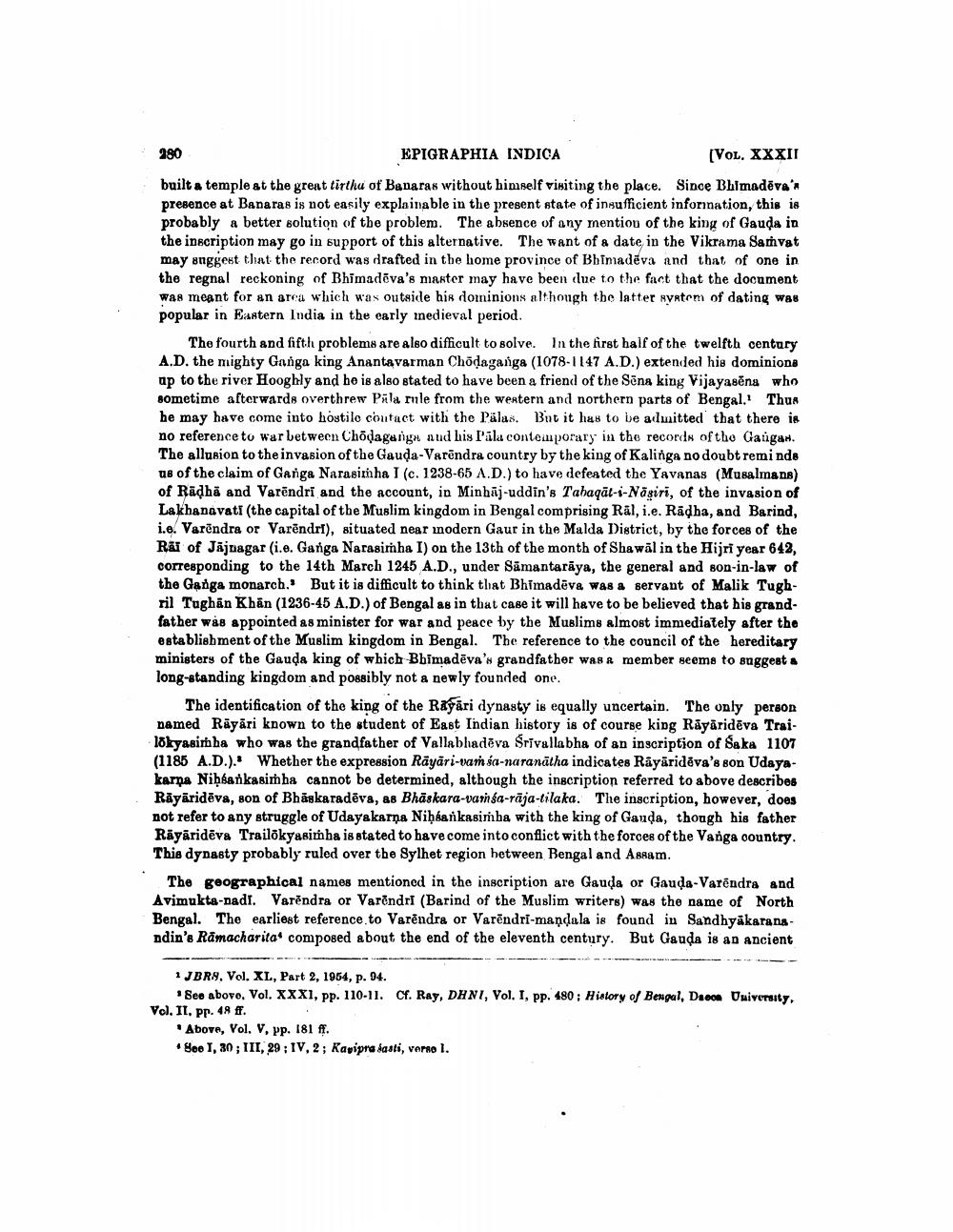________________
380
EPIGRAPHIA INDICA
(Vol. XXXII
built a temple at the great tirtha of Banaras without himself visiting the place. Since Bhimadēva' presence at Banaras is not easily explainable in the present state of insufficient information, this is probably a better solution of the problem. The absence of any mentiou of the king of Gauda in the inscription may go in support of this alternative. The want of a date in the Vikrama Samvat may anggest that the record was drafted in the home province of Bhimadēva and that of one in the regnal reckoning of Bhimadova's master may have been due to the fact that the document was meant for an area which was outside his doininions although the latter system of dating was popular in Eastern India in the early inedieval period.
The fourth and fifth problems are also difficult to solve. In the first half of the twelfth century A.D. the mighty Ganga king Anantavarman Chödaganga (1078-1147 A.D.) extended his dominions ap to the river Hooghly and he is also stated to have been a friend of the Söna king Vijayasēna who sometime afterwards overthrew Pala rule from the western and northern parts of Bengal. Thus he may have come into hostilo contact with the Palas. But it has to be admitted that there is no reference to war between Chödaganga and his Pūla contemporary in the records of the Gaugas. The allusion to the invasion of the Gauda-Varēndra country by the king of Kalinga no doubt reminds us of the claim of Ganga Narasimha I (c. 1238-65 A.D.) to have defeated the Yavanas (Musalmans) of Rādha and Varēndri and the account, in Minhāj-uddin's Tabaqal-s-Näsiri, of the invasion of Lakhanavati (the capital of the Muslim kingdom in Bengal comprising Ral, i.e. Rādha, and Barind, i.e. Varēndra or Varēndrr), situated near inodern Gaur in the Malda District, by the forces of the Rai of Jājnagar (i.e. Ganga Narasimha I) on the 13th of the month of Shawal in the Hijri year 642, corresponding to the 14th March 1245 A.D., under Sämantarāya, the general and son-in-law of the Ganga monarch.' But it is difficult to think that Bhimadeva was a servant of Malik Tugbril Taghan Khān (1236-45 A.D.) of Bengal as in that case it will have to be believed that his grandfather was appointed as minister for war and peace by the Muslims almost immediately after the establishment of the Muslim kingdom in Bengal. The reference to the council of the hereditary ministers of the Gauda king of which Bhimadēva's grandfather was a member seems to suggest a long-standing kingdom and possibly not a newly founded one.
The identification of the king of the Ragari dynasty is equally uncertain. The only person named Rāyāri known to the student of East Indian history is of course king Rāyaridēva Trailokyasimha who was the grandfather of Vallabhadēva Srivallabha of an inscription of Saka 1107 (1185 A.D.).' Whether the expression Rāyāri-vaṁía-naranātha indicates Räyärideva's son Udayakarna Nihsankasimha cannot be determined, although the inscription referred to above describes Rāyāridēva, son of Bhaskaradēva, as Bhāskara-varsa-rāja-tilaka. The inscription, however, does not refer to any struggle of Udayakarna Nihsarkasimba with the king of Gauda, though his father Rāyāridēva Trailökyasimha is stated to have come into conflict with the forces of the Vanga country. This dynasty probably ruled over the Sylhet region hetween Bengal and A Baam.
The geographical names mentioned in the inscription are Gauda or Gauda-Varēndra and Avimukta-nadi. Varendra or Varēndri (Barind of the Muslim writers) was the name of North Bengal. The earliest reference to Varēndra or Varēndri-mandala is found in Sandhyakarana ndin's Ramacharitat composed about the end of the eleventh century. But Gauda is an ancient
1 JBR9, Vol. XL, Part 2, 1954, p. 04.
* See abovo, Vol. XXXI, pp. 110-11. Cf. Ray, DHNI, Vol. I, pp. 480 ; History of Bengal, Dicon University, Vol. II. PP. 48 ff.
*Above, Vol. V, pp. 181 ff. Hoe 1, 30; III, 29; IV, 2; Raviprasasti, verso 1.




